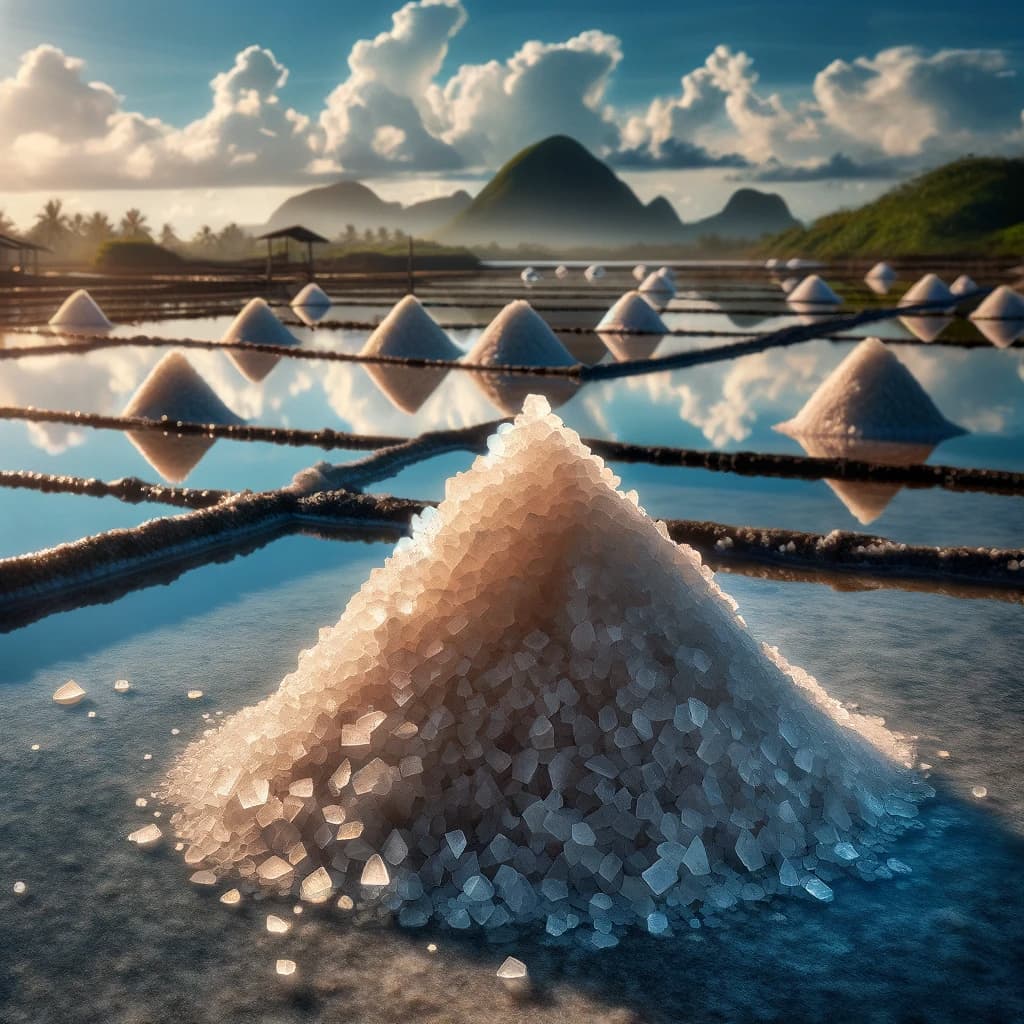Fleur de sel is a culinary treasure that has gained popularity in international cuisine due to its unique flavor and texture. This gourmet salt is obtained naturally and is considered a true luxury in the kitchen. In this article, we will explore what fleur de sel is, how it is obtained and what its characteristics and properties are.
Characteristics of Fleur de Sel
Fleur de sel is known for its distinctive characteristics that differentiate it from other common salts. Some of its main features are the following:
- Light Texture : Fleur de sel has a light, flaky texture that melts easily in the mouth. This unique texture is the result of the superficial crystallization of salt on the surface of the salt flats.
- Complex Flavor : Fleur de sel has a complex and delicate flavor. It is often described as salty but with mineral nuances and a slight hint of the sea.
- Pure White Color : Its color is generally pure white, which makes it visually attractive and appreciated in haute cuisine.
- Manual Harvesting : Harvesting fleur de sel is a manual process that requires skill and care. The collectors carefully scrape off the top layer of salt that forms on the surface of the salt flats.
How is Fleur de Sel extracted?
Obtaining fleur de sel is a meticulous process that involves the evaporation of seawater in shallow pools known as salinas. The process is described step by step below:

- Coastal Salt Flats : Fleur de sel is obtained from coastal salt flats located in regions with sunny climates and mild winds, such as the Mediterranean coasts of Spain or Portugal.
- Seawater Capture : The process begins with the capture of seawater in shallow ponds. This water is allowed to evaporate in the sun and wind.
- Formation of Salt Crystals : As water evaporates, common salt (sodium chloride) crystallizes at the bottom of the salt pans, while fleur de sel forms on the surface due to the action of the winds. mild and moderate temperatures.
- Manual Harvesting : Experienced salt pan collectors carefully scrape the top layer of the salt pan, collecting the precious fleur de sel. This process is delicate and is done by hand to avoid damaging the crystals.
- Sun Dried : Once harvested, fleur de sel is dried in the sun to remove any excess moisture.
Why is it called Fleur de Sal?
The name “fleur de sel” comes from its appearance and formation process. The top layer of salt collected in salt pans has an appearance that resembles delicate white flowers floating on the surface of the water. This poetic image of small “flowers” of salt has given rise to its distinctive name.
How is Fleur de Sel Different from Other Salts?
Fleur de sel differs from other salts, such as table salt or sea salt, in several important ways:
- Texture and Crystal Size : Fleur de sel has a lighter texture and larger crystals compared to table salt, which is usually finer and more compact.
- Flavor and Aroma : Fleur de sel has a more complex flavor and aroma due to its mineral and marine content. This salt enhances the flavors of foods without overpowering them.
- Obtaining Process : Fleur de sel is formed on the surface of salt flats through a natural evaporation process, while other salts are obtained from underground brine extraction or mining.
- Main Use : Fleur de sel is mainly used as a final seasoning to enhance already prepared dishes, while other salts are used in cooking and food preparation.
What are the Properties of Fleur de Sel?
Fleur de sel is not only appreciated for its flavor and texture, but it also has some unique properties that make it special:
- Minerals : Contains a variety of minerals, such as magnesium, calcium, and potassium, which may provide health benefits.
- Low Sodium : Although still a source of sodium, fleur de sel tends to be slightly less salty than other salts due to its crystalline structure, meaning you can use less to achieve the same flavor.
- Culinary Texture : Its flaky and delicate texture makes it ideal for adding a finishing touch to gourmet dishes such as salads, grilled meats or desserts.
- Flavor Enhancement : Fleur de sel highlights and enhances the flavors of foods without overpowering them, making it a perfect complement to sophisticated dishes.
Recommendations for the Use of Fleur de Sel
Fleur de sel is a versatile ingredient in gourmet cooking, but should be used sparingly due to its concentrated flavor. Here are some recommendations on how to use it:
- Final Seasoning : Fleur de sel is best used as a final seasoning just before serving a dish. This allows its crystals to dissolve slightly and adhere to the surface of the food.
- Salads : Sprinkle a little fleur de sel on your salads to enhance the flavor of fresh ingredients.
- Grilled Meats : Add a pinch of fleur de sel to your grilled meats just before serving for an explosion of flavor.
- Desserts : Fleur de sel can also be used in desserts, especially chocolates and caramel, to balance sweetness.
- Ethnic Cuisine : Experiment with fleur de sel in dishes from different cuisines around the world, as it can add a touch of elegance to your culinary creations.
Who can consume it?
Fleur de sel is generally safe to consume for most people, as long as it is used in moderation. However, people with dietary restrictions, such as those with hypertension or kidney disease, should be aware of their sodium intake and talk to a health professional before incorporating it regularly into their diet.
What is the Flor de Sal of Colima?
Colima fleur de sel is a variety of fleur de sel that is produced in the coastal region of the state of Colima, Mexico. This fleur de sel is especially appreciated for its purity and quality. It is obtained from the salt flats on the Mexican Pacific coast and is characterized by its mild flavor and delicate texture. Colima fleur de sel is highly valued in both local and international cuisine and is used in a wide variety of gourmet dishes.
In short, fleur de sel is a culinary treasure that adds flavor and sophistication to your dishes. Its manual production process and its unique flavor make it a desired ingredient in haute cuisine. Add a touch of elegance to your dishes and experiment with this wonderful gourmet salt in your kitchen.




0 Comments